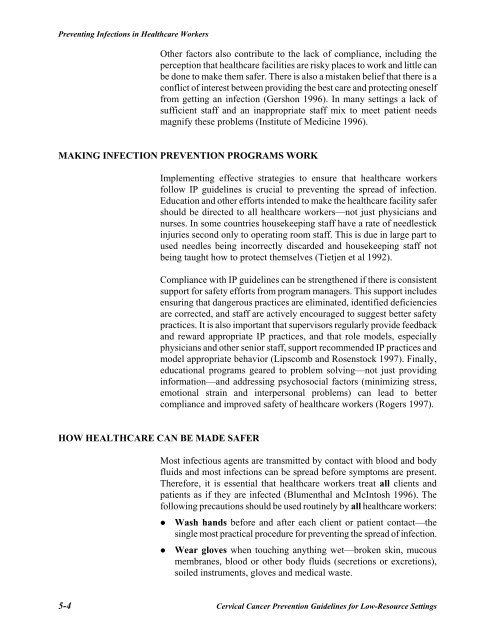Reference Manual - IARC Screening Group
Reference Manual - IARC Screening Group
Reference Manual - IARC Screening Group
Create successful ePaper yourself
Turn your PDF publications into a flip-book with our unique Google optimized e-Paper software.
Preventing Infections in Healthcare WorkersOther factors also contribute to the lack of compliance, including theperception that healthcare facilities are risky places to work and little canbe done to make them safer. There is also a mistaken belief that there is aconflict of interest between providing the best care and protecting oneselffrom getting an infection (Gershon 1996). In many settings a lack ofsufficient staff and an inappropriate staff mix to meet patient needsmagnify these problems (Institute of Medicine 1996).MAKING INFECTION PREVENTION PROGRAMS WORKImplementing effective strategies to ensure that healthcare workersfollow IP guidelines is crucial to preventing the spread of infection.Education and other efforts intended to make the healthcare facility safershould be directed to all healthcare workers—not just physicians andnurses. In some countries housekeeping staff have a rate of needlestickinjuries second only to operating room staff. This is due in large part toused needles being incorrectly discarded and housekeeping staff notbeing taught how to protect themselves (Tietjen et al 1992).Compliance with IP guidelines can be strengthened if there is consistentsupport for safety efforts from program managers. This support includesensuring that dangerous practices are eliminated, identified deficienciesare corrected, and staff are actively encouraged to suggest better safetypractices. It is also important that supervisors regularly provide feedbackand reward appropriate IP practices, and that role models, especiallyphysicians and other senior staff, support recommended IP practices andmodel appropriate behavior (Lipscomb and Rosenstock 1997). Finally,educational programs geared to problem solving—not just providinginformation—and addressing psychosocial factors (minimizing stress,emotional strain and interpersonal problems) can lead to bettercompliance and improved safety of healthcare workers (Rogers 1997).HOW HEALTHCARE CAN BE MADE SAFERMost infectious agents are transmitted by contact with blood and bodyfluids and most infections can be spread before symptoms are present.Therefore, it is essential that healthcare workers treat all clients andpatients as if they are infected (Blumenthal and McIntosh 1996). Thefollowing precautions should be used routinely by all healthcare workers:• Wash hands before and after each client or patient contact—thesingle most practical procedure for preventing the spread of infection.• Wear gloves when touching anything wet—broken skin, mucousmembranes, blood or other body fluids (secretions or excretions),soiled instruments, gloves and medical waste.5-4 Cervical Cancer Prevention Guidelines for Low-Resource Settings
















